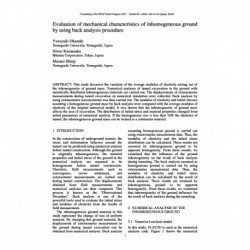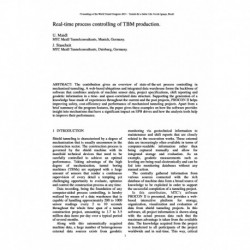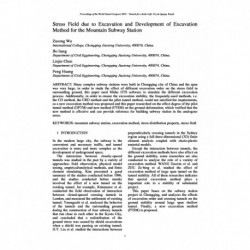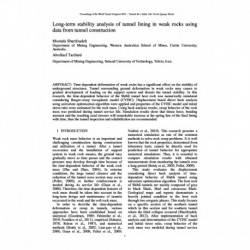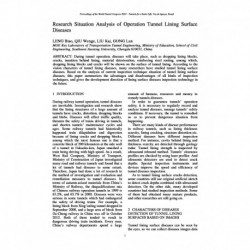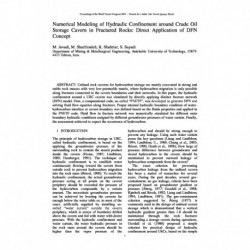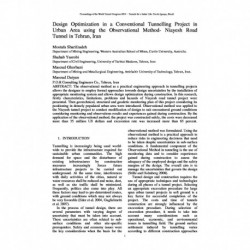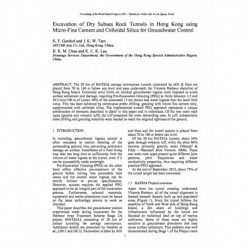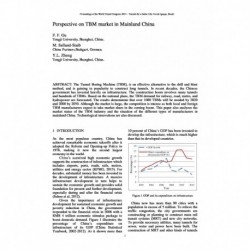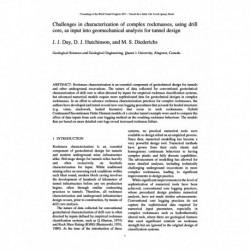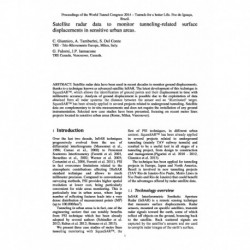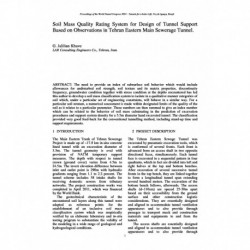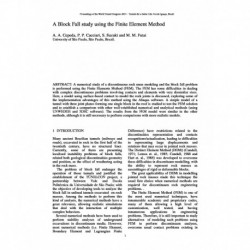No document
Search & filter
Search for a publication
Search & filter
Papers from WTC and ITA conferences have been made available as PDF documents.
ProceedingsThere are 1984 documents.
List of endorsed conferences
-
WTC
World Tunnelling Congress
-
Evaluation of mechanical characteristics of inhomogeneous ground by using back analysis procedure
Abstract: This study discusses the variation of the average modulus of elasticity arising out of the inhomogeneity of ground mass. Numerical analyses of tunnel excavation in the ground with statistically distributed inhomogeneous materials are carried out. The displacements of extensometer measurements during tunnel excavation on numerical simulation were collected. Back...
0,00 € -
Real-time process controlling of TBM production
Abstract: The contribution gives an overview of state-of-the-art process controlling in mechanized tunneling. A web-based ubiquitous and integrated data warehouse forms the backbone of software that combines analysis of machine sensor data, project specifications, shift reporting and geodetic information in a time- and space-correlated data structure. Supporting the generation of a knowledge base made of...
0,00 € -
Stress Field due to Excavation and Development of Excavation Method for the Mountain Subway Station
Abstract: Many complex subway stations were built in Chongqing city of China and the span was very large, in order to study the effect of different excavation order on the stress field in surrounding ground, this paper used Midas GTS software to simulate the different excavation process. Additionally, in order to ensure the excavation stability, the frequently-used methods, i.e. the CD method, the CRD...
0,00 € -
Long-term stability analysis of tunnel lining in weak rocks using data from tunnel construction
Abstract: Time-dependent deformation of weak rocks has a significant effect on the stability of underground structures. Tunnel surrounding ground deformation in weak rocks may causes to gradual development of loading on the support system and threats the tunnel stability. In this research, the time-dependent behavior of the Shibli tunnel host rock was numerically...
0,00 € -
Research Situation Analysis of Operation Tunnel Lining Surface Diseases
Abstract: During tunnel operation, diseases will take place, such as dropping lining blocks, cracks, inanition behind lining, material deterioration, reinforcing steel rusting, among which, dropping lining blocks and cracks will be shown on the surface of tunnel lining. According to the vision characters of tunnel lining diseases, many researchers have...
0,00 € -
Numerical Modeling of Hydraulic Confinement around Crude Oil Storage Cavern in Fractured Rocks: Direct...
Abstract: Unlined rock caverns for hydrocarbon storage are mainly excavated in strong and stable rock masses with very low-permeable matrix, where hydrocarbon migration is only possible along fractures connected to the cavern boundaries and their networks. In this paper, the hydraulic confinement around a URC cavern was simulated by directly applying distinct fracture network...
0,00 € -
Estimation of Rock Load for Tunnels Excavated in Different Rock Masses
Abstract: Collapses in roof and less frequently in walls and face often take place due to inappropriate estimation of rock load. This study offers a review of the main factors affecting rock load to evaluate the capabilities of the existing models for prediction of ground pressure acting against installed support in underground excavations. Rock mass classifications such as GSI, RMR, as well as tunnel...
0,00 € -
Design Optimization in a Conventional Tunnelling Project in Urban Area using the Observational Method-...
Abstract: The observational method as a practical engineering approach in tunnelling projects allows the designer to employ formal approaches towards design uncertainties by the installation of appropriate monitoring system and allows design optimization during construction. In this research, firstly characteristics, limitations, problems and hazards of Niayesh road tunnel project...
0,00 € -
Excavation of Dry Subsea Rock Tunnels in Hong Kong using Micro-Fine Cement and Colloidal Silica for Groundwater Control
Abstract: The 20 km of HATS2A sewage conveyance tunnels excavated by drill & blast are placed from 70 to 160 m below sea level and pass underneath the Victoria Harbour shoreline of Hong Kong Island. Extremely strict limits on residual groundwater ingress were imposed to avoid surface settlement and damage, requiring Pre-Excavation Grouting (PEG) to limits between 2.5 and 50 L/min/100 m of tunnel. 89%...
0,00 € -
Perspective on TBM market in Mainland China
Abstract: The Tunnel Boring Machine (TBM), is an effective alternative to the drill and blast method, and is gaining in popularity to construct long tunnels. In recent decades, the Chinese government has invested heavily on infrastructure. The construction boom involves many tunnels and hundreds of TBMs. Based on the national plans, the TBM demand for railway, road,...
0,00 € -
Storage of highly compressed gases in underground Lined Rock Caverns – More than 10 years of experience
Abstract: The world’s first LRC (Lined Rock Cavern) storage facility is since 10 years in commercial operation as a part of the Swedish natural gas grid. This paper describes the 40 000 m size storage and the process from design, construction, tests and operation. The unique cavern wall structure can, in interaction with the surrounding rock mass, resist pressures of more than 20 MPa and...
0,00 € -
Influence of soil-pipe relative stiffness on the behavior of buried pipelines undergoing elevation
Abstract: Longitudinal interactions of buried pipelines represent three-dimensional problems arising from many different particular situations involving a specific location of the pipeline, such as landslides, expansive soils, sinkholes, soil collapse, just to name a few. This paper aimed at developing a three-dimensional numerical evaluation of the mechanical behavior of buried pipelines undergoing...
0,00 € -
Challenges in characterization of complex rockmasses, using drillcore, as input into geomechanical analysis for...
Abstract: Rockmass characterization is an essential component of geotechnical design for tunnels and other underground excavations. The nature of data collected for conventional geotechnical characterization of drill core is often directed by inputs for empirical rockmass classification systems, but advanced numerical models require more sophisticated data for geotechnical designs in complex rockmasses....
0,00 € -
Satellite radar data to monitor tunneling-related surface displacements in sensitive urban areas
Abstract: Satellite radar data have been used in recent decades to monitor ground displacements, thanks to a technique known as advanced satellite InSAR. The latest development of this technique is SqueeSAR™, which allows the identification of ground points and their displacement in time with millimetric accuracy. Analysis of ground displacement is possible due to the exploitation of data obtained from...
0,00 € -
Soil Mass Quality Rating System for Design of Tunnel SupportBased on Observations in Tehran Eastern Main Sewerage Tunnel
Abstract: The need to provide an index of subsurface soil behavior which would includeallowances for undisturbed soil strength, soil texture and its matrix properties, discontinuityfrequency, groundwater condition together with stress condition at the depths encountered has ledthis author to develop a soil mass classification system to isolate in a qualitative manner categories ofsoil which, under a...
0,00 € -
A Block Fall study using the Finite Element Method
Abstract: A numerical study of a discontinuous rock mass modeling and the block fall problem is performed using the Finite Elements Method (FEM). The FEM has some difficulties in dealing with complex discontinuous problems involving contacts and elements with very dissimilar sizes. Here, a model using surface-based contact to model the rock joints is discussed, exploring some of the implementation...
0,00 €


